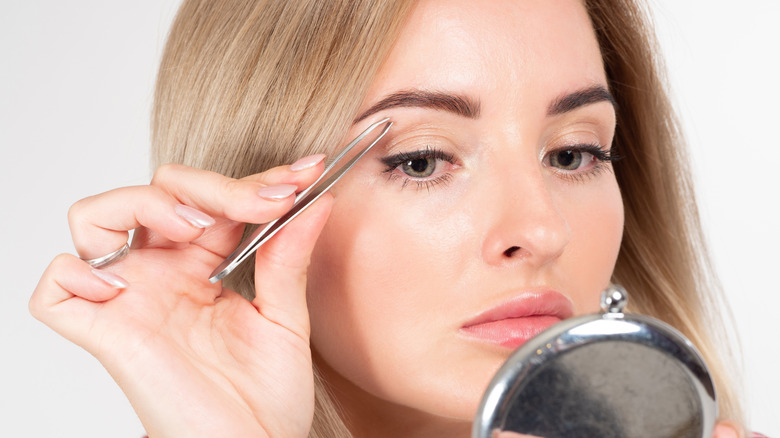When Is It Safe To Remove An Ingrown Hair At Home?
Ingrown hairs can be a nuisance, but they can also be extremely painful. According to Mayo Clinic, ingrown hairs come about when a hair that has been removed — typically by tweezing, waxing or shaving — grows back abnormally by curving itself into the skin rather than growing properly out of the skin. Noticeable signs of an ingrown sign include small, swollen bumps that can be inflamed, itch, or be painful. Most ingrown hairs resolve on their own, but some may need to be removed. When you have an ingrown hair, it may be your first instinct to try to rip it out yourself, but that isn't always the best way to go about removing a struggling ingrown hair.
Because shaving, waxing, and tweezing is usually performed on areas with coarser hair, those areas are the most common to experience ingrown hairs, reports Self. The coarser the hair, the more likely it is to become tightly curled and grow back into the skin. When a hair doesn't grow properly from its follicle root and becomes ingrown, it may take up to a month for the ingrown hair to resolve on its own (per Mayo Clinic). Sometimes it can even take six months for ingrown hairs to correct themselves. But if an ingrown hair is particularly painful, infected, or bothersome, here's what you should know about removing it yourself.
When to remove ingrown hairs
Ingrown hairs that don't resolve on their own and are left for too long, or ingrown hairs that you try to forcibly remove at home with improper technique and tools that aren't sterile, can lead to many undesirable side effects including bacterial infections and scarring (per Mayo Clinic). One thing to be mindful of is that scratching an itchy ingrown hair can introduce bacteria from your hands and fingernails, and lead to an infection. Although it's likely easier said than done, the best thing to do when you have an ingrown hair is to leave it alone and let your body take over the care. If you simply can't stand an ingrown hair, or if you have concerns about a growing infection, always consult with your healthcare provider.
The only time that it may be safe to remove an ingrown hair at home is if the hair is looped outside of the skin and you can easily tweeze it out without digging into the skin (per Self). Even if you can see an ingrown hair beneath the skin, never try to force it out or dig into your skin as doing so can lead to scarring, more irritation, and a worsened infection that could make the situation drastically worse. Only if you can see a loop above the skin should you try at-home removal, and only use tweezers that have first been cleaned with alcohol for sterilization.
Treatment and prevention of ingrown hairs
When you have an ingrown hair, there are ways to ease symptoms like itchiness, inflammation, pain, and swelling (via Self). Applying a warm compress to an ingrown hair can decrease inflammation, swelling, and pain. A warm compress can also make it easier for the hair to push itself out of the skin. Following the use of a compress, you can very gently exfoliate the area with a clean washcloth to further help the hair make its way through the skin. The steadfast rule when you have an ingrown hair is not just to avoid picking at it, but you should also refrain from performing any hair removal procedures, like shaving or waxing, on the area (per Mayo Clinic).
The National Health Service (NHS) advocates for proper skin care practices that can serve to prevent ingrown hairs altogether. Recommendations include avoiding the use of blunt razors when shaving, and not shaving too close to the skin. Though it may seem tedious, it's best practice to rinse your razor after every shaving stroke to prevent clogs in both the razor and your skin's hair follicles. Always shave using warm water with shaving cream or gel, and shave in the direction of hair growth rather than against the grain. One hack to add into your hair removal routine is to apply a cool, wet washcloth or towel to recently shaved skin for the purpose of calming inflammation and giving your skin a jump start to recovery.



